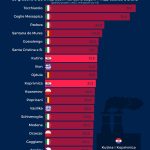ZAGREB, August 6, 2019 – A Finance Ministry analysis of data on budget execution in 2018 shows that last year Croatian towns absorbed more than 314 million kuna from EU funds, three times more than in 2017, when 89 million kuna was absorbed, with the northern Adriatic port city of Rijeka and the island town of Komiža being the most successful, according to the gradonacelnik.hr web portal.
Last year towns signed ten times more contracts for EU-funded projects than in 2015 and three times more than in 2017, with projections for this year indicating a further increase.
Apart from the fact that the number of towns which last year contracted money for EU-funded projects grew, from 75 in 2017 to 97 in 2018, the amount of the funding grew as well. In 2017 the town of Lipik was the recorder, with EU funding absorbed amounting to 233 kuna per capita, and only nine other towns absorbed more than 100 kuna per capita.
In 2018 those figures grew tenfold, with the town of Komiža on the island of Vis being the best performer, with 2,505 kuna of EU money absorbed per capita. It was followed by Pleternica, with 1,222 kuna, Lipik, with 1,157 kuna, and Opuzen, with 1,117 kuna. The ten best performers also include Grubišno Polje, Nin, Otok, Pazin, Hvar and Prelog.
In terms of the share in the total amount of EU funding contracted, last year’s best performer was Rijeka, with a share of more than 10%. It was followed by Osijek, Pleternica, Petrinja, Virovitica, Vukovar, Požega, Koprivnica, Šibenik and Zadar.
The gradonacelnik.hr web portal notes that these figures include only EU funding contracted directly or indirectly by towns as project managers and do not include funding contracted by town institutions or local companies and the towns themselves as project partners, which makes it realistic to assume the contracted amount is actually higher.
In the last five years, the most successful towns in terms of absorption of EU funding were Ludbreg, which had the highest average amount of EU funding absorbed – 544 kuna per capita annually – and Zadar, which was the best performer in terms of the share of EU funding in the total amount of EU funding contracted, with a share of more than 7%.
Most of EU-funded projects so far have referred to environmental protection, cultural heritage and entrepreneurship.
More news about EU funds can be found in the Business section.







